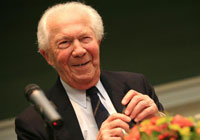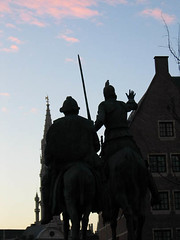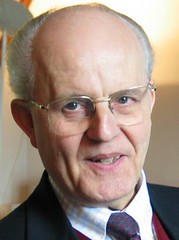Confidencias del Nobel lovaniense Ch. de Duve
12.02.09 @ 23:58:59. Archivado en Universidades, Pro amicitia universale, Ciencias biomédicas
 “Tenéis que saber que el premio Nobel no lo da Dios, sino un grupo de suecos. Asi que no hay que atribuirle demasiada importancia. Yo puedo citaros media docena de belgas que lo merecerían”.
“Tenéis que saber que el premio Nobel no lo da Dios, sino un grupo de suecos. Asi que no hay que atribuirle demasiada importancia. Yo puedo citaros media docena de belgas que lo merecerían”.
Declaración de Christian de Duve a propósito de su premio Nobel en medicina, obenido en 1974. Palabras pronunciadas durante su encuentro con los estudiantes de medicina, con ocasión de su 90 aniversario. Actualmente tiene 91 años y cuatro meses.
-oOo-oOo-oOo-
The Nobel Prize in Physiology or Medicine 1974
Autobiography
Cosmopolita y políglota, nace en 1917 de padres belgas refugiados en Inglaterra
I was born on October 2nd 1917, in Thames-Ditton, near London. My parents, of Belgian-German extraction, were Belgian nationals who had taken refuge in England during the war. They returned to Belgium in 1920, and I grew up in the cosmopolitan harbour city of Antwerp, at a time when education in the Flemish part of the country was still half French and half Flemish. Due to these various circumstances, when I entered the Catholic University of Louvain in 1934, I had already travelled in a number of European countries and spoke four languages fairly fluently. This turned out to be a valuable asset in my subsequent career as a scientist.
Alumno de los jesuitas en Humanidades clásicas; estudiante, médico e investigador lovaniense
That I would embrace such a career was, however, very far from my mind. My education, according to the tradition of the jesuit school which I attended, had been centered on the "ancient humanities", and I was strongly attracted to the more literary branches. I nevertheless decided to study medicine, largely because of the appeal of medical practice as an occupation. Medical studies left a fair amount of free time in those days, and there was a tradition at the university that the better students joined a research laboratory. So it was that I entered the physiology laboratory of Professor J. P. Bouckaert, whose rigorous analytical mind exerted a strong influence on my intellectual development. I was attached to a group investigating the effect of insulin on glucose uptake. By the time when I graduated as an MD in 1941, I had abandoned all thought of a medical career, and had only one ambition: to elucidate the mechanism of action of insulin.
Movilizado como soldado; hecho prisionero de la segunda guerra mundial, logra escapar; de nuevo estudiante lovaniense de Química, al mismo tiempo que interno en cancerología
In the meantime, war had broken out. After a brief interval in the army and a temporary stay in a prisoners' camp, from which I promptly escaped thanks to the general confusion which followed the disastrous defeat of the allies, I had returned to Louvain to complete my studies. I had become convinced that the problem of insulin action needed to be approached by means of biochemical methods. Since research activities were almost paralysed due to lack of essential supplies, I embarked an another four-year curriculum, to gain the degree of "Licencié en Sciences Chimiques". I combined these studies with a clinical internship in the Cancer Institute, with as much experimental work as war circumstances allowed, and with extensive reading of the earlier literature on insulin.
Alumno de Joseph Maisin. Agregado de la enseñanza superior en 1945 con una tesis sobre "Glucosa, Insulina y Diabete"
As a medical student, I had been rather relaxed, but I worked really hard during those four years. Still I could not have achieved what I did without the support of my clinical chief, Professor Joseph Maisin, who enthusiastically approved of my plans and gave me a great deal of free time. By 1945, I had presented a thesis on the mechanism of action of insulin, which earned me the degree of "Agrégé de l'Enseignement Supérieur", written a 400-page book entitled "Glucose, Insuline et Diabète", and prepared a number of research articles for publication.
En 1946-1947 profundiza la bioquímica en el laboratorio del futuro Nobel 1955 Hugo Theorellen del Medical Nobel Institute in Stockholm,
By that time, the war had ended and I felt a great need of further training in biochemistry. In 1946-1947, I had the good fortune of spending 18 months at the Medical Nobel Institute in Stockholm, in the laboratory of Hugo Theorell, who was awarded the Nobel Prize in 1955. I then spent 6 months as a Rockefeller Foundation fellow at Washington University, under Carl and Gerty Cori who jointly received the Nobel Prize while I was there. In St. Louis, I collaborated with Earl Sutherland, Nobel laureate in 1971. Indeed, I have been very fortunate in the choice of my mentors, all sticklers for technical excellence and intellectual rigour, those prerequisites of good scientific work.
En marzo de 1947 comienza a enseñar la química fisiológica en la facultad de medicina de Lovaina, siendo nombrado profesor en 1951
I returned to Louvain in March 1947 to take over the teaching of physiological chemistry at the medical faculty, becoming full professor in 1951. I started a small research laboratory, where I was joined by a young physician, Gery Hers, who had already worked with me during the war, and by an increasing number of first class students, including Jacques Berthet, Henri Beaufay, Robert Wattiaux, Pierre Jacques and Pierre Baudhuin. All have since carved distinguished careers for themselves.
"El destino tenía en su trastienda una sorpresa para mí, bajo la forma de una oportunidad de observación de la llamada "latencia" de la fosfatasa ácida".
Insulin, together with glucagon which I had helped rediscover, was still my main focus of interest, and our first investigations were accordingly directed on certain enzymatic aspects of carbohydrate metabolism in liver, which were expected to throw light on the broader problem of insulin action. But fate had a surprise in store for me, in the form of a chance observation, the so-called "latency" of acid phosphatase. It was essentially irrelevant to the object of our research but it was most intriguing. My curiosity got the better of me, and as a result I never elucidated the mechanism of action of insulin. I pursued my accidental finding instead, drawing most of my collaborators along with me.
Descubrimiento de una nueva parte de las células, el lisosoma, que recibió su nombre en 1955, y más tarde de otro órgano diminuto: el peroxisoma.
Our investigations were very fruitful. They led to the discovery of a new cell part, the lysosome, which received its name in 1955, and later of yet another organelle, the peroxisome. At the same time, we were prompted to develop progressively improved instrumental, technical and conceptual tools in relation to the separation and analysis of cell components, and to apply them to an increasing variety of problems of biological and also medical interest.
En 1962 es invitado como professor del "Rockefeller Institute" de Nueva York, la actual Rockefeller University
In 1962, I was appointed a professor at the Rockefeller Institute in New York, now the Rockefeller University, the institution where Albert Claude had made his pioneering studies between 1929 and 1949, and where George Palade had been working since 1946. I retained my position in Louvain and have since shared my time more or less equally between the two universities. In New York, I was able to develop a second flourishing group, which follows the same general lines of research as the Belgian group, but with a program of its own. The two laboratories work closely together and complement each other in many respects.
Creación lovaniense del "International Institute of Cellular and Molecular Pathology"
Recently, with a number of colleagues, I have created a new institute, the International Institute of Cellular and Molecular Pathology, or ICP, located on the new site of the Louvain Medical School in Brussels. The aim of the ICP is to accelerate the translation of basic knowledge in cellular and molecular biology into useful practical applications.
Casado desde 1943 con Janine Herman, de cuyo matrimonio tiene cuatro hijos
In September 1943, I married the former Janine Herman, the daughter of a physician. We have four children, three of whom are married, and two grandchildren.
From Les Prix Nobel en 1974, Editor Wilhelm Odelberg, [Nobel Foundation], Stockholm, 1975
This autobiography/biography was written at the time of the award and later published in the book series Les Prix Nobel/Nobel Lectures. The information is sometimes updated with an addendum submitted by the Laureate. To cite this document, always state the source as shown above.
Copyright © The Nobel Foundation 1974
Addendum, December 1997
Abuelo de siete nietos. Profesor emérito lovaniense desde 1985 y de la Rockefeller University desde 1988
Since the writing of this note, our fourth child has married and the number or our grand-children has risen to 7. I still share my time between Belgium and New York, but my professional duties have slowly come to an end. I became emeritus at the University of Louvain in 1985 and at the Rockefeller University in 1988. My duties as president of the ICP ended in 1991, but I still remain on the board of this institute, as Founder-Administrator.
Relación estrecha entre la investigación fundamental del ICP y las aplicaciones clínicas, con una atención particular al cáncer
Much of my time and effort have been devoted to the ICP, where some 270 investigators and technicians work on a variety of problems of basic science and on the application of their findings to medical progress. About one-third of the institute is occupied by the Brussels branch of the Ludwig Institute for Cancer Research. The head of this branch, Professor Thiery Boon, is also my successor as director of the ICP.
Investigación y publicaciones recientes sobre el origen y la evolución de la vida. Interés por ver lo que nuestra creciente comprensión de la vida y la mente nos puede decir acerca de la estructura y el sentido del universo.
In the last few years, I have become increasingly interested in the origin and evolution of life. I have written three books, which have been translated in a number of languages: A Guided Tour of the Living Cell (New York: Scientific American Books, 1984); Blueprint for a Cell (Burlington, NC: Neil Patterson Publishers, 1991); and Vital Dust (New York: Basic Books, 1995). I plan to devote my remaining years to further probing what, if anything, our growing understanding of life and mind can tell us about the structure and meaning of the universe.
Copyright © The Nobel Foundation 1997
-oOoo-oOo-oOo-



